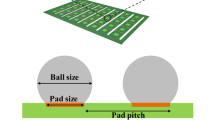Abstract
Generally, lead-free solder joints in electronic device are near single or multi crystalline rather than poly crystalline, and the fatigue failure behavior of solder joints is greatly influenced by the solder joint thickness. In this study, the grain number and orientation of solder joints with four solder thicknesses (0.1, 0.2, 0.3, 0.6 mm) were analyzed and the effect of that on the low cycle fatigue deformation behavior of solder joint was also investigated. The orientation analysis was conducted by means of electron backscatter diffraction and the fatigue test was performed under room temperature with a fixed frequency of 1 Hz. Moreover, the deformation evolution on side surface of solder joint was observed by utilizing scanning electron microscope. It is shown that there is no preferred solidification orientation for lead-free solder joints. However, grains in one joint seem to have a similar orientation when the solder thickness is <0.3 mm. Solder joint grain number increases with solder thickness. Besides, the slip direction and slip band density are different for grains with different orientations. Consequently, the deformation on both sides of the grain boundary is inhomogeneous and the fatigue crack is prone to initiate and propagate in this area.








Similar content being viewed by others
References
A.U. Telang, T.R. Bieler, A. Zamri, F. Pourboghrat, Acta Mater. 55, 2265–2277 (2007)
W.W. Lee, L.T. Nguyen, G.S. Selvaduray, Microelectron. Reliab. 40, 231–244 (2000)
H. Rhee, K.N. Subramanian, Solder. Surf. Mt. Technol. 18(1), 19–28 (2006)
A.U. Telang, T.R. Bieler, Scr. Mater. 52, 1027–1031 (2005)
A.U. Telang, T.R. Bieler, JOM 6, 44–49 (2005)
P. Zimprich, U. Saeed, A. Betzwar-Kotas, B. Weiss, H. Ipser, J. Electron. Mater. 37(1), 102–109 (2008)
M. Sona, K.N. Prabhu, J. Mater. Sci. Mater. Electron. 24, 3149–3169 (2013)
S.H. Yang, Y.H. Tian, C.Q. Wang, J. Mater. Sci. Mater. Electron. 21, 1174–1180 (2010)
J.T. Liu, Z.G. Wang, J.K. Shang, Acta Metall. Sin. 44(12), 1409–1414 (2008)
J. Zhao, Y. Mutoh, Y. Miyashita, S.L. Mannan, J. Electron. Mater. 31(8), 879–886 (2002)
H. Conrad, Z. Guo, Y. Fahmy, D. Yang, J. Electron. Mater. 28(9), 1062–1070 (1999)
L.M. Yin, X.P. Zhang, C.S. Lu, J. Electron. Mater. 38(10), 2179–2183 (2009)
P. Yang, Electron backscatter diffraction technology and its applications (Beijing, 2007), pp. 141–157
D. Shangguan, Lead-free solder interconnect reliability (ASM international, Geauga, 2005), pp. 84–128
Acknowledgments
This study was financially supported by National Natural Science Foundation of China (No. 51275007) and Key Project of Beijing Educational Committee Scientific Research Plan (No. KZ201410005009), which were acknowledged.
Author information
Authors and Affiliations
Corresponding author
Rights and permissions
About this article
Cite this article
Gao, R., Li, X. & Zhu, Y. Investigation on the effect of Sn grain number and orientation on the low cycle fatigue deformation behavior of SnAgCu/Cu solder joints. J Mater Sci: Mater Electron 26, 2175–2180 (2015). https://doi.org/10.1007/s10854-015-2664-5
Received:
Accepted:
Published:
Issue Date:
DOI: https://doi.org/10.1007/s10854-015-2664-5




